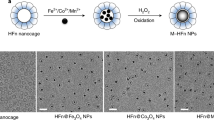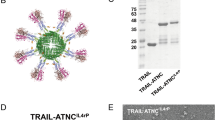Abstract
Trivalent arsenic (AsIII) is an effective agent for treating patients with acute promyelocytic leukaemia, but its ionic nature leads to several major limitations like low effective concentrations in leukaemia cells and substantial off-target cytotoxicity, which limits its general application to other types of leukaemia. Here, building from our clinical discovery that cancerous cells from patients with different leukaemia forms featured stable and strong expression of CD71, we designed a ferritin-based As nanomedicine, As@Fn, that bound to leukaemia cells with very high affinity, and efficiently delivered cytotoxic AsIII into a large diversity of leukaemia cell lines and patient cells. Moreover, As@Fn exerted strong anti-leukaemia effects in diverse cell-line-derived xenograft models, as well as in a patient-derived xenograft model, in which it consistently outperformed the gold standard, showing its potential as a precision treatment for a variety of leukaemias.
This is a preview of subscription content, access via your institution
Access options
Access Nature and 54 other Nature Portfolio journals
Get Nature+, our best-value online-access subscription
$29.99 / 30 days
cancel any time
Subscribe to this journal
Receive 12 print issues and online access
$259.00 per year
only $21.58 per issue
Buy this article
- Purchase on Springer Link
- Instant access to full article PDF
Prices may be subject to local taxes which are calculated during checkout






Similar content being viewed by others
Data availability
The main data supporting the results in this study are available within the paper and Supplementary Information. The raw and analysed datasets generated during the study are too large to be publicly shared, yet they are available for research purposes from the corresponding author on reasonable request.
References
Siegel, R. L., Miller, K. D. & Jemal, A. Cancer statistics, 2019. CA Cancer J. Clin. 69, 7–34 (2019).
Miller, K. D. et al. Cancer treatment and survivorship statistics, 2019. CA Cancer J. Clin. 69, 363–385 (2019).
Lhermitte, L. et al. Automated database-guided expert-supervised orientation for immunophenotypic diagnosis and classification of acute leukemia. Leukemia 32, 874–881 (2018).
Bassan, R. & Hoelzer, D. Modern therapy of acute lymphoblastic leukemia. J. Clin. Oncol. 29, 532–543 (2011).
Nabhan, C. & Rosen, S. T. Chronic lymphocytic leukemia: a clinical review. J. Am. Med. Assoc. 312, 2265–2276 (2014).
Short, N. J. et al. Advances in the treatment of acute myeloid leukemia: new drugs and new challenges. Cancer Discov. 10, 506–525 (2020).
Lo-Coco, F. et al. Retinoic acid and arsenic trioxide for acute promyelocytic leukemia. N. Engl. J. Med. 369, 111–121 (2013).
Zhang, X. W. et al. Arsenic trioxide controls the fate of the PML-RARα oncoprotein by directly binding PML. Science 328, 240–243 (2010).
Chen, G. Q. et al. In vitro studies on cellular and molecular mechanisms of arsenic trioxide (As2O3) in the treatment of acute promyelocytic leukemia: As2O3 induces NB4 cell apoptosis with downregulation of Bcl-2 expression and modulation of PML-RAR alpha/PML proteins. Blood 88, 1052–1061 (1996).
Wang, X. et al. Arsenene: a potential therapeutic agent for acute promyelocytic leukaemia cells by acting on nuclear proteins. Angew. Chem. Int. Ed. 59, 5151–5158 (2020).
Yedjou, C., Tchounwou, P., Jenkins, J. & McMurray, R. Basic mechanisms of arsenic trioxide (ATO)-induced apoptosis in human leukemia (HL-60) cells. J. Hematol. Oncol. 3, 28 (2010).
Chen, H. M. et al. Lipid encapsulation of arsenic trioxide attenuates cytotoxicity and allows for controlled anticancer drug release. J. Am. Chem. Soc. 128, 13348–13349 (2006).
Qian, C. et al. Suppression of pancreatic tumor growth by targeted arsenic delivery with anti-CD44v6 single chain antibody conjugated nanoparticles. Biomaterials 34, 6175–6184 (2013).
Dilda, P. J. et al. Insight into the selectivity of arsenic trioxide for acute promyelocytic leukemia cells by characterizing Saccharomyces cerevisiae deletion strains that are sensitive or resistant to the metalloid. Int. J. Biochem. Cell Biol. 40, 1016–1029 (2008).
Emadi, A. & Gore, S. D. Arsenic trioxide — an old drug rediscovered. Blood Rev. 24, 191–199 (2010).
Sahu, G. R. & Jena, R. K. Significance of intracellular arsenic trioxide for therapeutic response in acute promyelocytic leukemia. Am. J. Hematol. 78, 113–116 (2005).
Davila, M. L. et al. Efficacy and toxicity management of 19-28z CAR T cell therapy in B cell acute lymphoblastic leukemia. Sci. Transl. Med. 6, 224Rra25 (2014).
Grupp, S. A. et al. Chimeric antigen receptor-modified T cells for acute lymphoid leukemia. N. Engl. J. Med. 368, 1509–1518 (2013).
Bielamowicz, K. et al. Trivalent CAR T cells overcome interpatient antigenic variability in glioblastoma. Neurooncol. 20, 506–518 (2018).
Zhou, Y. et al. Advances in the molecular pathobiology of B-lymphoblastic leukemia. Hum. Pathol. 43, 1347–1362 (2012).
Fry, T. J. et al. CD22-targeted CAR T cells induce remission in B-ALL that is naive or resistant to CD19-targeted CAR immunotherapy. Nat. Med. 24, 20–28 (2018).
Qin, H. Y. et al. Preclinical development of bivalent chimeric antigen receptors targeting both CD19 and CD22. Mol. Ther. Oncolytics 11, 127–137 (2018).
Zah, E., Lin, M. Y., Silva-Benedict, A., Jensen, M. C. & Chen, Y. Y. T Cells expressing CD19/CD20 bispecific chimeric antigen receptors prevent antigen escape by malignant B cells. Cancer Immunol. Res. 4, 639–641 (2016).
Peng, Y. et al. Smart human-serum-albumin-As2O3 nanodrug with self-amplified folate receptor-targeting ability for chronic myeloid leukemia treatment. Angew. Chem. Int. Ed. 56, 10845–10849 (2017).
Ellison, P. A. et al. Intrinsic and stable conjugation of thiolated mesoporous silica nanoparticles with radioarsenic. ACS Appl. Mater. Interfaces 9, 6772–6781 (2017).
Zhang, K. et al. An extracellular pH-driven targeted multifunctional manganese arsenite delivery system for tumor imaging and therapy. Biomater. Sci. 7, 2480–2490 (2019).
Li, L. et al. Binding and uptake of H-ferritin are mediated by human transferrin receptor-1. Proc. Natl Acad. Sci. USA 107, 3505–3510 (2010).
Montemiglio, L. C. et al. Cryo-EM structure of the human ferritin–transferrin receptor 1 complex. Nat. Commun. 10, 1121 (2019).
Fan, K. et al. Ferritin nanocarrier traverses the blood brain barrier and kills glioma. ACS Nano 12, 4105–4115 (2018).
Ding, F. et al. Enhancing the chemotherapeutic efficacy of platinum prodrug nanoparticles and inhibiting cancer metastasis by targeting iron homeostasis. Nanoscale Horiz. 5, 999–1015 (2020).
Kawabata, H. Transferrin and transferrin receptors update. Free Radic. Biol. Med. 133, 46–54 (2019).
Lyons, V. J., Helms, A. & Pappas, D. The effect of protein expression on cancer cell capture using the human transferrin receptor (CD71) as an affinity ligand. Anal. Chim. Acta 1076, 154–161 (2019).
Fan, K. et al. Magnetoferritin nanoparticles for targeting and visualizing tumour tissues. Nat. Nanotechnol. 7, 459–464 (2012).
Liang, M. et al. H-ferritin-nanocaged doxorubicin nanoparticles specifically target and kill tumors with a single-dose injection. Proc. Natl Acad. Sci. USA 111, 14900–14905 (2014).
Douglas, T. et al. Synthesis and structure of an iron(III) sulfide–ferritin bioinorganic nanocomposite. Science 269, 54–57 (1995).
Sun, C. J. et al. Controlling assembly of paired gold clusters within apoferritin nanoreactor for in vivo kidney targeting and biomedical imaging. J. Am. Chem. Soc. 133, 8617–8624 (2011).
Wang, W. et al. Dual-targeting nanoparticle vaccine elicits a therapeutic antibody response against chronic hepatitis B. Nat. Nanotechnol. 15, 406–416 (2020).
Meldrum, F. C., Heywood, B. R. & Mann, S. Magnetoferritin: in vitro synthesis of a novel magnetic protein. Science 257, 522–523 (1992).
Meldrum, F. C., Wade, V. J., Nimmo, D. L., Heywood, B. R. & Mann, S. Synthesis of inorganic nanophase materials in supramolecular protein cages. Nature 349, 684–687 (1991).
Dilda, P. J. & Hogg, P. J. Arsenical-based cancer drugs. Cancer Treat. Rev. 33, 542–564 (2007).
Spuches, A. M., Kruszyna, H. G., Rich, A. M. & Wilcox, D. E. Thermodynamics of the As(III)-thiol interaction: arsenite and monomethylarsenite complexes with glutathione, dihydrolipoic acid, and other thiol ligands. Inorg. Chem. 44, 2964–2972 (2005).
Pozzi, C. et al. Iron binding to human heavy-chain ferritin. Acta Crystallogr. D Biol. Crystallogr. 71, 1909–1920 (2015).
Hutter, J., Iannuzzi, M., Schiffmann, F. & VandeVondele, J. CP2K: atomistic simulations of condensed matter systems. Wires Comput. Mol. Sci. 4, 15–25 (2014).
Becke, A. D. Density-functional exchange-energy approximation with correct asymptotic-behavior. Phys. Rev. A 38, 3098–3100 (1988).
Goedecker, S., Teter, M. & Hutter, J. Separable dual-space Gaussian pseudopotentials. Phys. Rev. B 54, 1703–1710 (1996).
Grimme, S. Accurate description of van der Waals complexes by density functional theory including empirical corrections. J. Comput. Chem. 25, 1463–1473 (2004).
Acknowledgements
This work was supported by the National Natural Science Foundation of China (U2001224, 21821005, 21725301, 21821004, 51622211), the Strategic Priority Research Program of the Chinese Academy of Sciences (XDB29040303), the National Key R&D Program of China (2017YFA0207900), the Open Funding Project of the State Key Laboratory of Biochemical Engineering (2012KF-03), Guangzhou Regenerative Medicine and Health Guangdong Laboratory (2018GZR110105014), the Natural Science Foundation of Guangdong Province (2018B030311042) and the Beijing Outstanding Young Scientist Program (BJJWZYJH01201914430039). D.M. acknowledges support from the Tencent Foundation through the XPLORER PRIZE.
Author information
Authors and Affiliations
Contributions
W.W., G.M., D.M. and Y.L. conceived and designed the study; W. Zhang, C.W. and C.Z. constructed the nanomedicine and performed in vitro experiments; C.W., Y. He, S.Y. and W.W. analysed the clinical samples; Z.G., W. Zhou and J.S. conducted high-resolution aberration-corrected electron microscope analysis; H.L. and L.L. contributed to quantum mechanical calculations; C.W. performed in vivo experiments on CDX models; C.W., Y. He and Y. Hu conducted leukaemia supression efficiency analysis on PDX model; S.W., F.L. and H.Y. helped with the animal experiments and facilitated the data and file processing; W.W. and C.W. wrote the manuscript; and W.W., G.M., D.M. and Y.L. further revised the manuscript.
Corresponding authors
Ethics declarations
Competing interests
The authors declare no competing interests.
Additional information
Peer review information Nature Nanotechnology thanks Monica Guzman and the other, anonymous, reviewer(s) for their contribution to the peer review of this work.
Publisher’s note Springer Nature remains neutral with regard to jurisdictional claims in published maps and institutional affiliations.
Supplementary information
Supplementary Information
Supplementary Figs. 1–32, Table 1 and Methods.
Rights and permissions
About this article
Cite this article
Wang, C., Zhang, W., He, Y. et al. Ferritin-based targeted delivery of arsenic to diverse leukaemia types confers strong anti-leukaemia therapeutic effects. Nat. Nanotechnol. 16, 1413–1423 (2021). https://doi.org/10.1038/s41565-021-00980-7
Received:
Accepted:
Published:
Issue Date:
DOI: https://doi.org/10.1038/s41565-021-00980-7
This article is cited by
-
Impact of doxorubicin-loaded ferritin nanocages (FerOX) vs. free doxorubicin on T lymphocytes: a translational clinical study on breast cancer patients undergoing neoadjuvant chemotherapy
Journal of Nanobiotechnology (2024)
-
Expression of TFRC helps to improve the antineoplastic effect of Ara-C on AML cells through a targeted delivery carrier
Journal of Nanobiotechnology (2023)
-
Development and application of nanomaterials, nanotechnology and nanomedicine for treating hematological malignancies
Journal of Hematology & Oncology (2023)
-
Destroying pathogen-tumor symbionts synergizing with catalytic therapy of colorectal cancer by biomimetic protein-supported single-atom nanozyme
Signal Transduction and Targeted Therapy (2023)
-
The landscape of cancer research and cancer care in China
Nature Medicine (2023)



